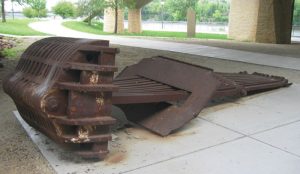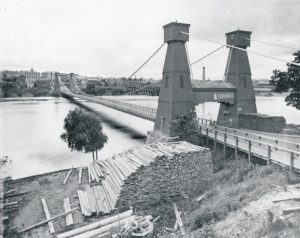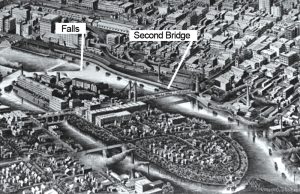19th Century Mississippi River Bridges Series
The Mississippi was the last major river to be crossed as the nation moved to the west. From its headwaters in Lake Itasca in Northern Minnesota to its discharge into the Gulf of Mexico, the river, with its tributaries, drained the entire United States between the Appalachians and the Rocky Mountains. It had a watershed of 1,245,000 square miles or approximately 40% of the country’s total land mass. It formed the boundary of ten states; Minnesota, Wisconsin, Iowa, Illinois, Missouri, Kentucky, Tennessee, Arkansas, Louisiana, and Mississippi. With the advent of the steamboat, it became a major shipping lane, and shippers wanted free navigation of the river without bridge piers.
In the early 19th Century, wood bridge builders like Timothy Palmer, Theodore Burr, and Lewis Wernwag built the first long-span bridges across the rivers in the eastern United States, precursors to the long spans that would be needed to cross the mighty Mississippi. They were followed by the iron truss bridge builders, Squire Whipple, Wendel Bollman, and Albert Fink. Then, starting with Charles Ellet, Jr., John A. Roebling, and Edward W. Serrell, iron wire cable suspension bridges were built across the Schuylkill, Niagara, Ohio, and Monongahela Rivers. These were built in relatively developed regions of the east and close to iron works and existing rail connections. The Mississippi, while not on the frontier, was close to it, and everything needed to build bridges had to be brought in from the east.
The Mississippi, with the challenges of required long spans, was a river that was tidal for much of its length and whose water level could vary as much as 20 feet in times of flood. Crossing the river required innovative approaches by engineers and bridge companies. In addition, many of the needed bridges required the approval of two states and the Federal government before being built. This series of articles chronologically describes how engineers of the 19th century met these challenges and designed and built bridges to cross the mighty river starting in 1855.

Fr. Louis Hennepin, a Franciscan Priest, first explored the upper Mississippi River. In 1680, he discovered St. Anthony Falls while searching for the river’s source. He named it in honor of St. Anthony of Padua. Two branches of the river flowed around Nicolett Island, and over time the cities of Minneapolis on the west bank and St. Anthony on the East Bank were settled. The only place the river could be crossed without a ferry was above the Falls on a rock ledge in the summer and over the ice in the winter.
As the population grew, Franklin Steele and John Stevens, two local businessmen, built a pile bridge from St. Anthony to the island and set up a rope ferry across the western channel. In March 1852, they received a charter from the Territorial Legislature (Minnesota did not become a state until 1858) to form the Mississippi Bridge Company. The questions were what kind of bridge should be built and who would design and build it? At the time, the population of the two cities totaled less than 1,500, and, even with the charging of tolls to cross the bridge, costs had to be kept to a minimum. In addition, a large number of piers in the river, even though on rock, would be expensive and hard to maintain given the problems with ice.
These constraints pointed to a suspension bridge with wrought iron wire cables and wooden or stone towers. Ellet’s 1842 Schuylkill River had stone towers, and his temporary 1849 bridge over the Niagara River had wooden towers. His 1,010-foot-span Wheeling Bridge across the Ohio River in 1849 had stone towers. Edward W. Serrell built his Lewiston/Queenston bridge across the Niagara River in 1851 and his St. John, New Brunswick Bridge in 1853, with Thomas M. Griffiths as his assistant, using wrought iron wire cables and stone towers. All of John A. Roebling’s short-span bridges, primarily for aqueducts, also had stone towers, and he was in the process of replacing Ellet’s Niagara Bridge with stone towers.
The Bridge Company selected Griffiths to design and build their bridge, probably with the help of Serrell, in 1854. His wooden towers “were strong frames of white pine timber, consisting each of 16 posts, 12 inches by 12 inches, so arranged that at each corner of a frustum of a right pyramid, with a square base of 14 feet by 14 feet, there were four respectively, but separated each from each by a space sufficient for the ventilation of the timber, and the passage of the tie bolts necessary to hold them together, and up to the system of interbracing. These posts were capped with three courses of white oak timber, the direction of the grain being reversed in each tier, and the whole trenailed through and through.” Cross bracing connected the towers at about the third point, and the entire tower was covered in wood, including widened caps over the tops of the towers.
His anchorages were custom-made to fit the site’s geology, which consisted of a 10-foot layer of limestone underlain by a layer of sand. Griffiths wrote, “The anchorage was obtained by working eight holes, eight inches wide and three feet long, through the limestone rock which is ten feet in thickness and of nearly horizontal stratification; underneath which lies the white sand. Through these holes, the link bars of the anchorage chains were thrust and secured to cast iron plates of about 1500 pounds each, which were taken into their positions underneath the ledge through tunnels driven into the easily excavated sand. Thus a very secure anchorage was obtained, at a comparatively small cost.”
For his cables, he wrote, “The four cables contained in all 2,000 strands of No. 10 hard drawn charcoal iron wire, made by Messrs. Cooper & Hewitt [Trenton, New Jersey]. These cables were formed of skeins of 124 and 126 strands, which were ‘laid up’ on the Island and moved and raised to their positions on the towers.” Note there were two separate “skeins” for each cable, and they were not wrapped into a single cable. From these cables, his suspenders “made of eight rounds of No. 10 wire formed into a skein; the upper end or ‘bite’ of which passed over a cast-iron yoke, which embraced the two cables on either side. The lower end or ‘bite,’ with a small casting interposed, supported either end of the floor beams.” The cables had a sag of 47 feet and were cradled 10 feet, meaning they were 10 feet closer together at midspan than at the tower for added lateral stiffness. The suspenders were spaced 3 feet 9 inches on-center and sloped from the cables back toward the towers.
His deck was 17 feet wide with 3½ by 14 inches cross floor beams placed 3 feet 9 inches on-center (the same as the spacing of the suspenders). Light stringers ran the length of the bridge with a deck surface of oak planks. Railings were in the form of Howe trusses for safety and added stiffness under each cable and down the centerline of the bridge. When done, Griffiths had built an inexpensive (~$36,000) suspension bridge with a main span of 620 feet across the Mississippi. It was opened on January 23, 1855, in a grand ceremony during the dead of a Minnesota winter. In his opening speech, the Territorial Governor, Willis A. Gorman, stated, “Who knows, but this mighty structure may yet bear the commerce of the Pacific, as it mingles with that of the Atlantic!” Griffiths, in writing about the opening, waxed poetic,
“… a hastily extemporized pageant glided at full gallop over the snow-covered rolling prairie (so soon to teem with the industry of a city), amid the jingle of sleigh bells, which in their numbers, vied supremacy over the discordant clang of a recently organized frontier band; and with the National colors borne aloft, from hill to hill, unfurled to full length in the dazzling sunlight by the Northern breeze, the generous enthusiasm of the occasion, gave vent to praises loud and long in honor of the bold projectors of the enterprise, and of those who had been mainly instrumental in its success.”
The bridge was damaged in a wind storm shortly after its opening but rebuilt in a short time. The toll for pedestrians was 3¢, or 5¢ for a round trip, horses and mules cost 15¢, cows and oxen cost 10¢, and pigs and sheep cost 2¢.
It was replaced in 1877 by Griffiths with another suspension bridge with ornate stone towers. Later in 1891, it, in turn, was replaced by a three-span steel arch bridge. However, the Fr. Hennepin Bridge will always hold the title of the first bridge across the Mississippi. Currently, another suspension bridge, the fourth at the site, opened in 1990 and continues to serve traffic.■


